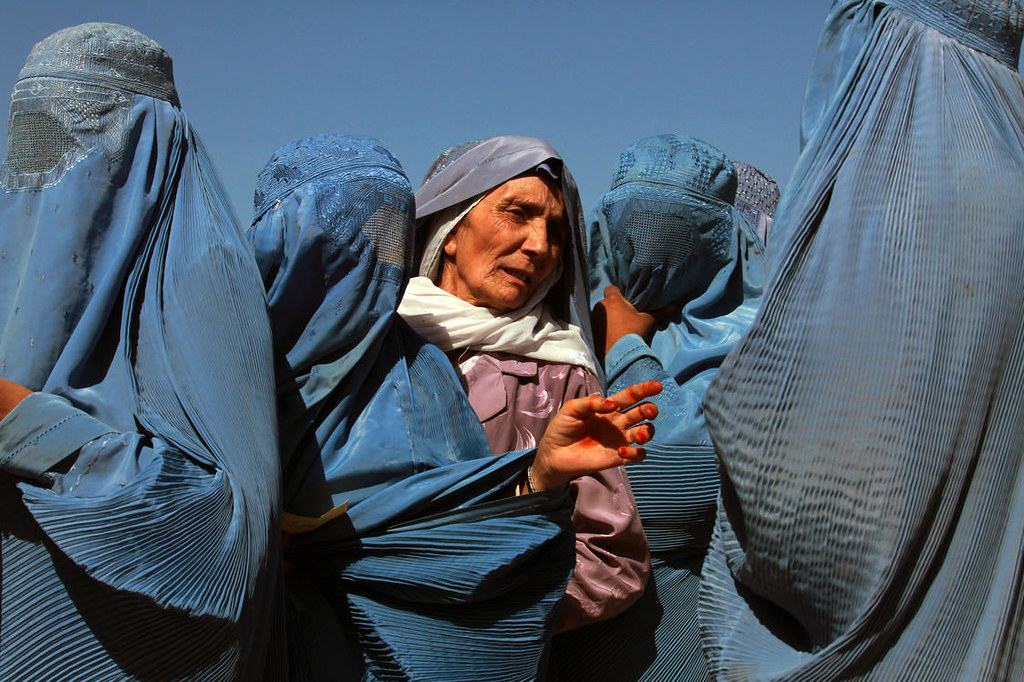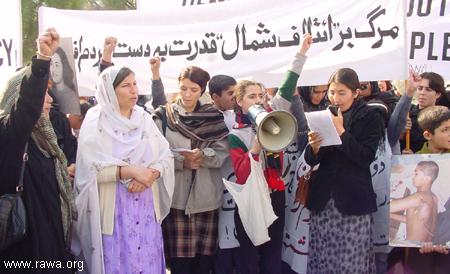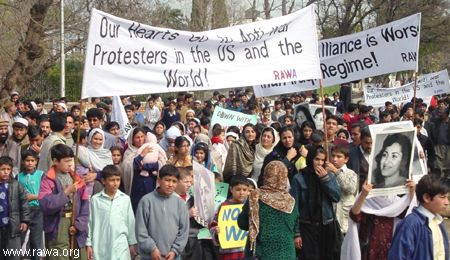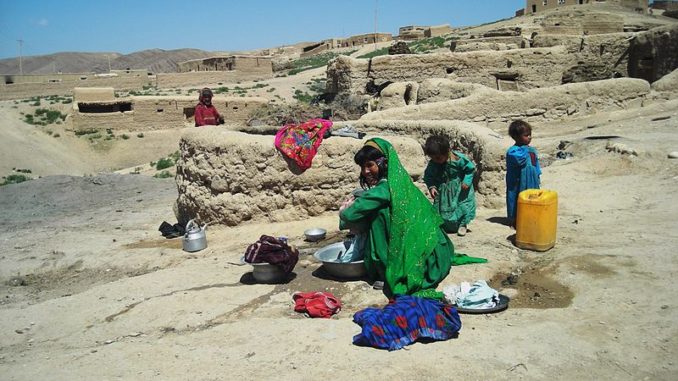By Alessandra Bajec
 Afghan women line up at a World Food Program distribution point / credit: United Nations photo licensed under CC BY-NC-ND 2.0
Afghan women line up at a World Food Program distribution point / credit: United Nations photo licensed under CC BY-NC-ND 2.0From the U.S. military intervention launched under the banner of democracy and human rights to restored warlords and the resuscitated Taliban regime, Afghan women have never stopped fighting for their rights.
When Taliban forces entered Kabul on August 15, appearing to have taken control of Afghanistan two weeks before the United States was set to complete its troop withdrawal, shock and fear for women’s fate under the Islamist group’s repressive rule quickly multiplied inside the country and globally.
After nearly 20 years of a U.S.-led coalition’s presence, a costly two-decade war, the very force the United States had tried to push out of power, in the name of its “War on Terror,” took over again. This time it occurred with stunning rapidity, in the wake of U.S. President Joe Biden’s hasty, chaotic military withdrawal.
With the U.S. exit from Afghanistan, hundreds of thousands of Afghan nationals were abandoned at the mercy of the Taliban, amid concern the fundamentalist movement would re-impose its hard-line interpretation of Islamic law on women and girls.
But securing women’s rights was used from the beginning to justify the U.S. military intervention. The Biden administration’s irresponsible pull-out in tandem with the swift, untroubled Taliban return speaks volumes about Washington’s lack of interest to secure respect for human rights and improve women’s lives. Humanitarian interventions have been used to deploy U.S. troops and drones in Iraq, Libya, Syria and other countries. As a consequence, 1 million people have been killed and an estimated 38 million have been forced to become refugees.
Condemning Humanitarian Interventions
The Revolutionary Association of the Women of Afghanistan (RAWA), the oldest feminist organization in Afghanistan, stated in its response to the Taliban takeover: “It is a joke to say values like ‘women’s rights,’ ‘democracy,’ ‘nation-building,’ etc., were part of the U.S./NATO aims in Afghanistan!”
 On International Human Rights Day, December 10, 2003, Afghan women of the Revolutionary Association of Women of Afghanistan (RAWA) marched to the UN headquarters in Islamabad, Pakistan. The sign states in Persian: “Down with the Northern Alliance, power to the Afghan people!” / credit: RAWA
On International Human Rights Day, December 10, 2003, Afghan women of the Revolutionary Association of Women of Afghanistan (RAWA) marched to the UN headquarters in Islamabad, Pakistan. The sign states in Persian: “Down with the Northern Alliance, power to the Afghan people!” / credit: RAWAThe women’s association mentioned the United States’ geostrategic motives for its invasion, namely causing regional instability to encircle its rival powers, China and Russia in particular, and to undermine their economies via regional wars.
“Right from the start, RAWA members have been saying that freedom can’t be brought through bombs, war and violence,” Sonali Kolhatkar, co-director of the Afghan Women’s Mission (AWM), a U.S.-based organization that funds RAWA’s work, told Toward Freedom. “How can they liberate women while they’re killing their husbands, brothers and fathers?”
Afghan women have long known that the U.S.-staged war on terrorism—and any foreign meddling—was not going to make their country safer. Women took the brunt of the backlash of war, military invasion and, again, today’s uncertain aftermath.
“[Afghan women] have always rejected outside interference, and maintained that Afghans need to fight for their freedom from inside,” Kolhatkar said.
For decades, active women have been at the forefront of opposing fundamentalism, warlordism and imperialism in Afghanistan.
Leading political activist and human-rights advocate Malalai Joya publicly denounced the presence of warlords and war criminals in the Afghan parliament in 2003 while serving as a member of parliament (MP), which resulted in her dismissal. An outspoken critic of the United States and NATO, she has continued to denounce the 20-year U.S./Western occupation. She has condemned U.S.-led drone attacks and bombings, clandestine raids carried out by U.S. and Afghan special forces into civilian homes, all of which have killed thousands of Afghans.
Between 2001 and 2020, more than 46,000 civilians were killed and 5.9 million Afghans displaced as a result of the war’s ongoing violence.
U.S. Brings Taliban Back to Power
Activists at the Afghan Women’s Network (AWN), an NGO launched in the mid-1990s, have criticized the United States for allegedly bribing and empowering warlords, then resuscitating the Taliban’s power in the 2020 U.S.-led negotiations in Doha, which translated into replacing one fundamentalist regime in Afghanistan with another.
“I do not understand the United States for undoing and now redoing the Taliban in Afghanistan, whose ruling will affect women’s lives the most, which will be ruined yet again,” prominent human-rights activist Mahbooba Seraj, member of AWN, said in a interview with TRT World.
Talking to Toward Freedom, Alia Rasoully, an Afghan based in the United States who founded WISE Afghanistan, an organization that aims to provide women access to health and education, underlined how the Doha talks were conducted solely in the United States’ interest. She said many Afghans are not aware of the agreement’s details.
 On April 28, 2003—known as the Black Day to commemorate the day the Taliban seized Kabul in 1992—other Afghan organizations joined RAWA in a demonstration / credit: RAWA
On April 28, 2003—known as the Black Day to commemorate the day the Taliban seized Kabul in 1992—other Afghan organizations joined RAWA in a demonstration / credit: RAWA“Afghan women feel betrayed,” Rasoully said. “Although some women were included in the negotiations, none of their demands for basic human and Islamic rights are being met today.”
Spozhmay Maseed, a U.S.-based Afghan rights activist, deplored the seemingly unconcerned U.S. pull-out. “It was shocking to everyone,” she told Toward Freedom. “U.S. forces were combating terrorists for 20 years, today they’re dealing with them. Who were they fighting then? What was that fight for?”
RAWA member Salma, whose real name must be concealed to protect her security, relayed similar concerns to Toward Freedom.
“The U.S. invasion of Afghanistan after 9/11 was a military operation orchestrated by the CIA that brought in Northern Alliance puppet leaders, who are as extremist and misogynist as the Taliban, and painted them as ‘democratic’ and ‘liberal,’” she said.
“What’s the result of these 20 years?” Salma asked. “[The United States] spent more than $2 trillion on the war to bring back the same Taliban, and it turned the country into a corrupt, drug-mafia and unsafe place, especially for women.”
The façade of democracy the United States had poured trillions of dollars into maintaining was lifted when former President Ashraf Ghani abandoned the presidential palace on August 15 by reportedly dashing onto a helicopter with close to $200 million in tow.
“How breakable that ‘democracy’ was, and how rotten the U.S.-backed puppet government was!” Salma asserted.
The Work of RAWA
On its website, RAWA has documented through its reports, photos and videos the horrific conditions facing Afghan women at the hands of the mujahideen and the Taliban, as well as the destruction and bloodshed during the U.S. occupation, which was rarely reported in the media.
“This indigenous women’s movement had long been trying to draw international attention to the atrocities against their people, in particular the ultra-woman-hating acts they were witnessing,” AWM’s Kolhatkar stressed. “It was only after September 11, when the world discovered there were terrible things happening to women in Afghanistan.”
Unlike many other Afghans, RAWA members have stayed, striving to give voice to the deprived women of Afghanistan in the struggle for women’s rights.
RAWA, which was established in 1977 as an independent political organization of Afghan women struggling for women’s rights, is driven by the belief that only a democratic, secular government can ensure security, independence and equality among Afghan people. It became involved in the struggle for resistance following
the Soviet intervention called for by the then-socialist government of Afghanistan in 1979. Over the last four decades, RAWA spoke out against the anti-Soviet resistance (known as mujahideen) in the 1980s, fought against the Taliban regime in the mid-1990s, denounced the role of the Pakistani state in creating the Taliban and has rejected the U.S. occupation of the last 20 years.
The women’s organization has been involved in various social and political activities to include literacy classes, schools for girls and boys in villages and remote areas, health and income-generation projects for women to help them financially, and political agitation. It has also worked with refugee Afghan women and children in Pakistan, running nursing, literacy and vocational training courses. In 1981, it launched a bilingual magazine in Persian and Pashto, Payam-e-Zan (Woman’s Message), spreading social and political awareness among Afghan women.
 An Afghan family in a village near Chagcharan Ghor province in 2007 / credit: Vida Urbonaite, Lithuania
An Afghan family in a village near Chagcharan Ghor province in 2007 / credit: Vida Urbonaite, LithuaniaDue to its pro-democracy, pro-secularist and anti-fundamentalist stance, RAWA has always operated as a clandestine organization, including in the last two decades under the U.S. occupation and the so-called “democratic government,” which it never recognized.
Using pseudonyms, concealing their identities, turning their homes into office spaces, often changing locations to avoid attention, its members have been active in different areas across Afghanistan. They would run underground schools for girls and women where they would use their burqa as a way to hide their books, and disseminate copies of Woman’s Message, secretly aiming to raise awareness among women of their rights and change their minds.
As an unregistered organization carrying out political work and home-schooling, if authorities found about its existence and illicit activity they could react punitively with any member caught up.
Since the assassination of its founder, Meena Kamal, the feminist association has been working more underground as anyone openly identified as member would risk being arrested or even killed. Despite it becoming increasingly dangerous to organize, the movement continues to stand.
“This is the time our women need us the most in Afghanistan,” Salma said. “We have to continue to be the voice of the voiceless who are here.”
Women’s Rights at What Cost?
Afghan women saw improvement in their lives over the past 20 years in terms of access to education, healthcare and employment, as well as economic, social and political empowerment. But the gap between urban centers and rural areas never really narrowed. In rural areas, where it is estimated 76 percent of Afghanistan’s women reside, women still rely on men in their families for permission to attend school and work. Girls are typically allowed to have primary or secondary education, then their families proceed with arranged marriages. In 2020, as little as 29.8 percent of women could read and write.
“Progress was slower in rural areas,” Rasoully remarked. “We worked hard in advocating to convince parents that their girls could safely go to school in a very culturally appropriate environment that they were comfortable with.”
She called for greater efforts to address the urban-rural divide, noting the international community made the mistake of taking an inequitable approach to offering educational opportunities to Afghan girls, as it directed its programs at young women in cities.
In her view, the insecurity brought on by the war into rural communities was a major impediment that kept girls out of school and prevented women from working.
Many villages experienced for years the devastation of heavy fighting between the Taliban, foreign militaries, government forces and local militias. The loss of husbands, brothers and fathers to the war further compromised women’s ability to go about everyday life.
Salma made clear progress in women’s status in the past two decades has been the result of a “natural process.” During that time, Afghan women acquired basic freedoms that had been withheld from them under the Taliban regime. But the foreign military presence could not be credited for that.
Kolhatkar specified that while the United States had boots on the ground in Afghanistan and it supported women’s rights on paper, the United States allowed the opposite in practice by “working with fundamentalists every step of the way.”
She explicitly said the issue of women’s rights was never a concern for Washington. Rather, it was a pretext to make its long, protracted occupation “palatable.”
“RAWA had been warning the Americans since the early phase of the invasion not to embrace the Taliban, nor the warlords,” Kolhatkar, AWM’s joint director, reminded. “It shouldn’t at all surprise us that the U.S. administration finally left Afghanistan, with misogynist hardliners in charge once again.”
With the Taliban back in control on August 15, a wave of civil resistance mainly was initiated by Afghan women. The protests have built momentum, hitting different parts of the war-ravaged country in the last month.
Further, a new generation has grown up in a country that is connected to the rest of the world through the Internet. That has increased political and social awareness among the general public, especially among young people.
Today, groups of women—small and large—are disobeying Taliban restrictions, protesting in Herat, Kabul, Mazar-e Sharif and other Afghan cities to demand their fundamental rights. They are bravely defying the extremist group, refusing the idea of returning to the grim days that women lived through.
Under the Taliban’s previous rule (1996-2001), the Islamist militants enforced strict rules on women and girls, forcing them to cover their bodies from head to toe, prohibiting them from leaving home without a male family member, and banning them from going to school or work. If they did not abide by the rules, they could face severe punishment, such as imprisonment, torture or execution.
Rasoully expressed concern that the progress made by 35 million Afghans throughout the last two decades, especially young women and girls, may go to waste. She personally mentored girls in medical school, in areas like Kandahar, over the last five years.
“But today, we are being told girls cannot go to school beyond sixth grade,” she said. “This will take us back to the stone ages.”
Maseed, the U.S.-based Afghan activist, insisted today’s Afghan women are better educated and more politically aware than in the 1990s, and will keep pushing for their rights.
“If women go backward, they think it’s better to come out on the streets and be killed than to follow these regressive rules and die inside every day,” the activist affirmed.
Resisting oppression with exceptional resilience—even under the new Taliban rule—they intend to keep up their struggle. They also are appealing to the international community not to grant recognition to the Taliban as a legitimate political actor.
In the past weeks, Afghan associations and supporters in the diaspora have joined Afghan women’s calls to refuse to recognize the Taliban. But they also have criticized the U.S. role in creating a disaster, at both political and humanitarian levels. And it is clear from U.S. machinations that ordinary Afghans will suffer starvation with recent efforts at keeping the Taliban from accessing funds stored in foreign banks.
“Perhaps things were better for many Afghan women under a U.S.-supported government, but it is also the United States’ violent intervention, which has led to the situation in Afghanistan today,” Nida Kirmani, a feminist sociologist and professor at Pakistan’s Lahore University of Management Sciences, wrote in a tweet. “One cannot disconnect the two.”

